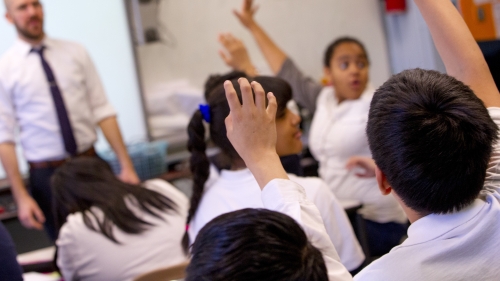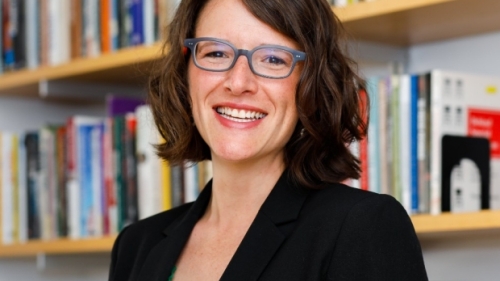This is the first in a series of articles highlighting NYU Steinhardt researchers in special education and disability studies who are working to break down barriers and improve equity.

In an era of increased attention toward inclusivity and equity, teachers, policymakers, and administrators in the related fields of special education and disability studies have new and complicated questions to unravel. Through the work of its scholars, NYU Steinhardt is making strides in both areas, bridging the two in ways that are generative for real solutions.
“There is a known issue of racial inequality in the education system writ large, with pockets of disproportionality that have to do with gender, poverty, race, and more,” says Audrey Trainor, professor of special education and content director for programs in special education, in the Department of Teaching and Learning at Steinhardt. “When identifying disabilities in children, the medical model tends to be the default. Examining those structural barriers, and learning how to dismantle them, deserves more of our attention.”
According to the U.S. Census, American Indian and Alaska Native, multi-racial, and Black children have a higher likelihood of being diagnosed with a disability. Similarly, children living in poverty are more likely to be diagnosed with a disability than those from higher socioeconomic groups.
Trainor is the principal investigator for Post-School Success for English Learners with Individualized Educational Plans (IEP), a study of high school students who receive both English learner and special education services as they transition to college and the workforce.
“Disproportionality is intersectional, and the receipt of English learner services is another key factor to be considered,” says Trainor. “American biases – especially in this particular moment in our history – about language instruction, bilingualism, immigration, race/ethnicity, and class can muddle our accurate identification of dually identified students. When it comes to life after high school, the point is to open doors, not shut them, so we’re working to increase these students’ access to choices by studying what leads to success and what gets in the way.”

"When it comes to life after high school, the point is to open doors, not shut them, so we’re working to increase these students’ access to choices by studying what leads to success and what gets in the way.”
Funded by the U.S. Department of Education, Institute for Education Sciences, Trainor’s project seeks to change ideas about what is possible and how society – from teacher to administrator to community member to employer – can support these students as they transition from high school to adulthood.
“There are structures and systems that are inherently unfair, such as inequity, personal biases, and structural challenges,” says Trainor. “Only recently has research and teacher education started to focus on dismantling them, and we are part of that deconstruction.”
The Post-School Success project offers ample multilingual resources for students, families, and educators, encompassing everything from college application tips to qualifying for Supplemental Security Income (SSI) after turning 18.
The original IES grant was awarded in 2017, and since then Trainor and her team have been working on data collection from their students and families. They are now in the dissemination phase and thinking about how to maximize the usefulness of the research by getting it in front of the people most likely to be impacted, such as teachers, administrators, and policymakers.
“We want to use our data to shed light on current policy in secondary and higher education around college and career readiness,” says Trainor. “Kids have a lot of creative ideas about the many options open to them, but do we as adults think in such divergent ways? There are a lot of ways you can start a career, and options like gap years, externships, and part-time employment need to be recognized and destigmatized – and not just for students with disabilities.”

Rachel Fish
The Role of Racism
Another Steinhardt Teaching and Learning faculty member interested in the intersection of racism and ableism – and how they matter for educational inequality – is Rachel Fish, assistant professor. Prior to joining NYU, she taught special education for five years in New Mexico and began to wonder why she had a disproportionate number of Navajo and Latinx students in her classroom.
“I went into teaching because I wanted to have an on-the-ground impact on the inequalities I saw growing up attending a variety of racially diverse schools,” says Fish. “As a teacher, I saw these disparities not only by race, but also by disability, and I didn’t see anyone paying attention to them.”
As a researcher, Fish examines the issue from a sociological perspective, publishing articles on issues such as how teachers perceive possible disability and giftedness differently by race, how race can influence teachers’ predictions of students’ performance, and even how teacher race can factor into the identification of disabilities in student populations.
Another of Fish’s research studies examines how school racial composition shapes inequalities in special education in Wisconsin, finding that when students stand out racially from their peers, inequalities in special education are exacerbated.
“In schools with more White students, I find Black, Latinx, and Native American students are more likely to be identified with more stigmatizing disability categories that tend to result in more exclusionary services, like emotional-behavioral disorder,” says Fish. “In schools with more students of color, White students are more likely to be identified with disability categories that tend to provide more accommodations and supports in the general education classroom, like ADHD. So, school context – especially the racial context – matters for how schools respond to student difficulties.”
For Fish, the current state of special education is just one level of intervention that needs closer examination.
